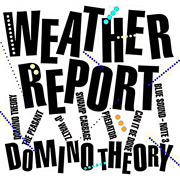Little Feat: Spanish Moon (1978)
Little Feat have always been a great live band, and their 1978 double LP Waiting for Columbus (one of the legendary live rock albums of the 70s, and the band’s best seller) is an excellent introduction to this country/funk/rock outfit, led by guitarist, singer and songrwriter, Lowell George, a great musician gone way too soon (at 34, in ’79). Spanish moon was originally included in their 1974 album Feats Don’t Fail Me Now, and is credited to George.
As you can hear, Little Feat wasn’t just Lowell George. It’s a pretty amazing band, with a funky rhythm section, expert players and grooves to burn. Moreover, for this tour (and other studio work as well) they hired the Tower of Power horn section, and these guys can play funk like very few horn sections can. If you don’t believe me, watch this 1973 tv appearance♾, where they kick some serious ass. Actually, Little Feat is still around, with the same personnel, more or less. They make albums, play gigs and have a website. I guess they must be fun to see live; but they don’t quite seem to capture the desperate and sublime intensity of Lowell George’s delivery, as in one of his best numbers, Willin’☊ (file under Songs about Driving).
Spanish moon is a cautionary tale about a bar by that name: “There’s whiskey, and bad cocaine, poison get you just the same, and if that don’t kill you soon, the women will down at the Spanish Moon.” But what lures people inside the place? A song. “Down the street I heard such a sorrowful tune, comin’ from the place they call the Spanish Moon”… “I stepped inside, and slipped by the door, while a dark girl sang, and played the guitar”… “Well I pawned my watch, and sold my ring, just to hear that girl sing, yeah, yeah”.
buy from amazon • buy from itunes • play on spotify
Weather Report: Can It Be Done (1984)
 I believe (and I have good reasons to, having been a fan of this band as a teenager) that this is the only proper song ever recorded by Weather Report. They played (and mostly wrote) many unforgettable tunes (like the catchiest of them all, Birdland), tracks, suites, pieces – but just this one song, sung by Carl Anderson. Can it be done was written by Willie Tee, a legendary New Orleans performer and friend of Joe Zawinul (half of the band, with saxophonist Wayne Shorter). His piano and voice version☊ is magnificent, so much so that I wasn’t sure which version to feature. The tune is circular, it has no chorus, yet it flows very naturally. It’s really a song about a potential (but perhaps impossible) song, and it has such beautiful lyrics, they’re worth reading:
I believe (and I have good reasons to, having been a fan of this band as a teenager) that this is the only proper song ever recorded by Weather Report. They played (and mostly wrote) many unforgettable tunes (like the catchiest of them all, Birdland), tracks, suites, pieces – but just this one song, sung by Carl Anderson. Can it be done was written by Willie Tee, a legendary New Orleans performer and friend of Joe Zawinul (half of the band, with saxophonist Wayne Shorter). His piano and voice version☊ is magnificent, so much so that I wasn’t sure which version to feature. The tune is circular, it has no chorus, yet it flows very naturally. It’s really a song about a potential (but perhaps impossible) song, and it has such beautiful lyrics, they’re worth reading:
Can it be done? Is there one melody that’s never been played? How does it sound? Can it be found – that new song, that’s never been in the air? I’ve searched so long it seems it just isn’t there, that melody that’s never been in the air. I look for a line that’s new, hoping to run into a new sound that’s never been heard.
I’ve heard a lot of music in my lifetime, and somehow it all sounds the same. Is there a sound to chose, one that’s never been used by anyone, anywhere?
Can it be done? Tell me is there one melody that’s never been played? How does it sound? Can it be found – that new song, that’s never been in the air? I’ve searched so long it seems it just isn’t there, that melody so fresh and so rare.
All instruments on this song are played – or programmed – by Joe Zawinul, a personal divinity of mine, and one of the most musical persons I’ve ever heard. Weather Report’s album Domino Theory (1984) is the very first album on which Zawinul used drum machines. And boy, has he used and abused them later on: the rhythm tracks his own 1986 Di•a•lects album (a minor masterpiece, if you ask me) are entirely programmed, in such a peculiar way that they sound neither like real drums, nor like regular drum machines (a good example is Carnevalito☊). In Can it be done, the drum programming is so sparse you don’t think of a machine. Zawinul’s comment: “If you listen to the ballad Can It Be Done, it has a perfect hi-hat beat. It cannot be played better. And you can shape that note here and there.” This quote, and other very interesting infos about the entire discography of this groundbreaking band, can be found on the excellent resource site Weatherreportdiscography.org.
buy from amazon • buy from itunes • play on spotify
Eva Cassidy: Tennessee Waltz (2002)
This song is immensely popular in the USA, and obviously even more in Tennessee – where is one of the state’s unofficial anthems. “Pee Wee King (born Julius Frank Anthony Kuczynski) and most of his group, the Golden West Cowboys, were riding in a limousine in 1946 when he and vocalist Redd Stewart co-wrote the song. They were on their way to a Grand Ole Opry appearance in Nashville when they heard Bill Monroe’s new Kentucky Waltz☊ on the radio. Stewart began writing the lyrics on a matchbox while King and the other musicians hummed King’s yet unnamed waltz.”
They recorded it in 1947, and the song became a hit in the Country & Western market. Patti Page covered it – as The Tennessee Waltz – as B-side to the (predictably corny) single Boogie Woogie Santa Claus☊ in 1950.” Her version went mainstream: “The Tennessee Waltz entered the Pop Music chart of Billboard dated 10 November 1950 for a 30 week chart run, with a #1 peak on the 30 December 1950 chart; the track would remain at #1 for a total of nine weeks. The Tennessee Waltz became Page’s career record”. And the song became an icon.
Every american Pop singer you can think of has recorded their version of Tennessee Waltz: Ray Charles, Sam Cooke, Leonard Cohen, James Brown, Tom Jones, Elvis – just to name a few. Being a simple song to play, on Youtube you can find a million Tennessee Waltz covers, tutorials on how to play it on any conceivable instrument, different karaokes for the various versions, etc.
There’s an Escheresque aspect to the lyrics of this song, another reason why it belongs to this issue of MOSS. It’s called Tennessee Waltz, but the songs clearly states that she (or he, according to the singer’s gender) lost her darling WHILE they were playing the beautiful Tennessee waltz. This song. How’s that even possible? Are they dancing to a song that talks about what’s happening to them? There are a number of interesting covers of this tune. The very classic C&W version by Hank Williams☊, the jazzy and intense Norah Jones live version♾ and my personal favorite – Eva Cassidy’s guitar and voice version (from her 2002 posthumous album Imagine). Here Tennessee waltz, stripped of any arrangement, takes on its true, sad meaning. Also thanks to a nifty musical trick (also deployed by Norah Jones, but with less impact: in the chorus, if you’re playing in in G, change the chord E from minor to major), the melody turns bluesy and sorrowful.
buy from amazon • buy from itunes • play on spotify
PS: If you haven’t had enough Tennessee Waltzes, someone has compiled a page with 50 versions (in streaming) on Archive.org.
*All quotes are from the excellent Wikipedia entry on this song.
